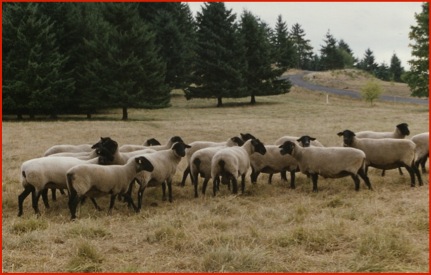Heritage Suffolks
After over 40 years in the Suffolk business, the Whispering Hills Flock was sold in 2018 to allow us to concentrate on our Shorthorn herd and reduce our overall work load. In order to maintain a historical perspective on Heritage Suffolks and the involvement that Whispering Hills Farm had, we are preserving some information here about Heritage Suffolks.
Heritage Suffolks conserve the genetics of old style classic Suffolks that have been systematically eliminated by show/club lamb breeders and show/club lamb judges. Heritage Suffolks combine the size, mass, milking ability, longevity, and style that made Suffolks the most popular sheep breed in the USA for over 50 years. Suffolks were renowned as the premier terminal sire breed in the sheep industry.
Whispering Hills Farm embraced the mantle of Heritage Suffolks through the conservation of genetics in a closed flock that revolved around a line breeding program using semen from the best rams that existed in the 70's and early 80's. No other flock in the world had the genetic base present in Whispering Hills Farm.
Given our 35 year involvement in the Suffolk industry we saw the transition from “The Breed in the Lead” to a breed looking for a direction. There are many reasons for the slow but consistent demise of the Suffolk breed since its peak in the 1988-1992 period. Certainly the Spider Syndrome and the often misplaced Scrapie finger-pointing were a large part of the decrease in both Suffolk registrations and transfers over the last 20 years. Whispering Hills Farm maintained a closed flock that used no crossbreeding and was 100% Suffolk.
Our belief is that the problem goes far beyond the Spider/Scrapie problem. Low Productivity, lack of longevity, poor style & body capacity (tall but narrow), and diminished feed efficiency are emblematic of what has been the downfall of Suffolks. Recently two long time Suffolk breeders made comments in the United Suffolk Sheep Association Member Spotlight section that highlights what has happened. John Sponaugle said
the folks ‘in charge’ have completely lost the concept of a good solid Suffolk sheep. Structural correctness and enough dimension to be productive must be addressed.
Lee Jarvis went even further saying
I feel like one problem we have in the Suffolk business today is that there are three different ‘types’ of Suffolk sheep: show ring Suffolks, commercial Suffolks, and wether-type Suffolks.
Both of these gentlemen have it right.
Most Suffolks today are not the Suffolks of 30-35 years ago. Many Suffolk breeders and “show judges” have no conceptual understanding of what constitutes a good sheep let alone a good Suffolk. Parsing the breed confuses breeders & buyers and is the principal reason Whispering Hills Farm stopped showing sheep 32 years ago. We came to the conclusion that we had to pursue a different course.
Show Ring Suffolks are typically narrow, tall with no mass, short lived and inefficient in feed conversion. Commercial Suffolks are shorter, more compact, generally structurally correct but lack classic Suffolk style or elegancy--instead being wooly-headed (hampy) with short airplane ears. Wether-type Suffolks are extremely compact, thick, short lived, and dystocia prone because of their pelvic structure. Black fiber is preferred, and “pick any style ears” is the norm. Most people do not realize that most wether lambs have surgically corrected rectums, eat expensive high energy diets (what is grass?), run on treadmills for hours to get the thick rear ends, and may be up to a year of age when shown instead of 4-5 months of age.

Whisper Suffolks embraced the breed standards of 30-35 years ago with genetics no one else has today. With a go it alone attitude our sheep combined the style of show Suffolks, the correctness/longevity of commercial Suffolks, and the thickness of wether sheep, while adding productivity, mothering ability, and feed efficiency. In essence, Whisper Suffolks are what Suffolks once were and should be again today.